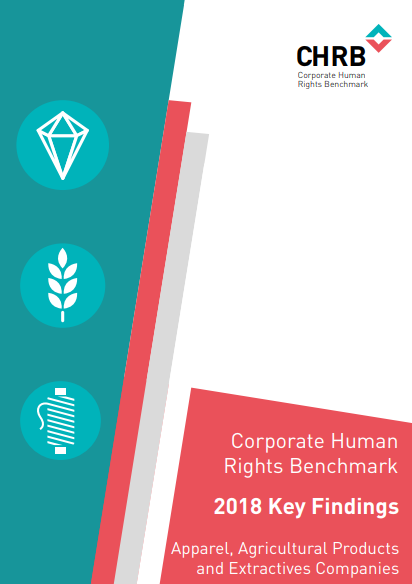Corporate Human Rights Benchmark: Pilot Methodology 2016
The CHRB pilot methodology assessed the top 100 companies across the agricultural products, apparel and extractives industries on their human rights policies, processes and performance.
The 2018 Corporate Human Rights Benchmark assesses 101 of the largest publicly traded companies in the world on a set of human rights indicators. The companies from 3 industries – Agricultural Products, Apparel, and Extractives – were chosen for the first Benchmark on the basis of their size (market capitalisation) and revenues and assessed across 6 Measurement Themes which have different weightings. Even though average scores are low across the board, overall companies tend to perform more strongly on policy commitments and management systems than on remedy or dealing with key risks in practice.

Average scores per region (source: CHRB 2018)
Some key takeaways from the results

The CHRB pilot methodology assessed the top 100 companies across the agricultural products, apparel and extractives industries on their human rights policies, processes and performance.
This Benchmark focuses on 98 companies of the three industries: Agricultural Products, Apparel, and Extractive. It is grounded in the UN Guiding Principles on Business and Human Rights, as well as additional standards and guidance focused on specific industries and...
The data in this report represents signals and cases from January 1, 2017 through December 31, 2017 and is accurate as of July 11, 2018. Cases of trafficking may be ongoing or new information may be revealed to the National Hotline over time. Conseq...Read More
On 10-12 November 2020, the USAID Asia Counter-Trafficking in Persons project hosted the 2020 CTIP Evidence Summit, "From Evidence to Action", which included the two Summit discussions "Barriers to Evidence Uptake — Civil Society Organization (CSO...Read More
Illegal, unregulated and unreported (IUU) fishing undermines the responsible management of commercial fishing and ocean conservation. It exploits the natural resources of coastal nations, reduces economic opportunity and threatens food security. IUU...Read More
This brief has been prepared by the Issara Institute and Anders Lisborg, technical consultant. The paper provides a brief landscape analysis of mainstream trafficking victim assistance programs in Southeast Asia from the lens of empowerment, emph...Read More